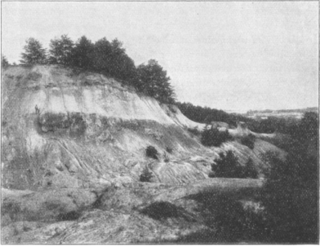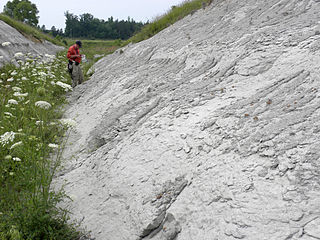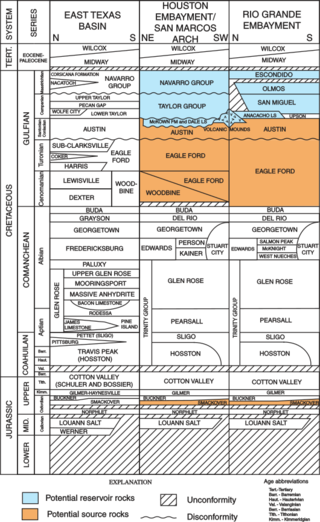Zanclites is an extinct genus of prehistoric ray-finned fish.
Emarginachelys cretacea is a turtle belonging to the group Cryptodira, known from well preserved fossils from the Maastrichtian stage of the Late Cretaceous of Montana. Its exact phylogenetic position within Cryptodira is uncertain; different authors considered it to be either the earliest described chelydrid or a fossil relative of kinosternoids.
Kinkonychelys is an extinct genus of side-necked turtle which existed in Madagascar during the Late Cretaceous period. It contains the single species Kinkonychelys rogersi, named in honor of its discoverer, Raymond R. Rogers. The genus and species are based on UA 9748, a nearly complete skull, which represents the first turtle skull described from the pre-Holocene era in Madagascar. A number of isolated skull and jaw bones have also been assigned to K. rogersi. These specimens were found in rocks of the Maastrichtian-age Maevarano Formation in the Mahajanga Basin of northwestern Madagascar. Another specimen, FMNH PR 2446, is speculated to represent another species, currently known as Kinkonychelys sp., but consensus on its distinction from K. rogersi remains unclear.
The Black Creek Group is a Late Cretaceous -aged geologic group in the southeastern United States, where it is known from the coastal plain of North Carolina and South Carolina. Deposited in brackish or nearshore marine conditions, it preserves fossils, including a diversity of dinosaurs and marine reptiles.
The Tar Heel Formation, also known as the Coachman Formation in South Carolina, is a Late Cretaceous geologic formation in North Carolina and South Carolina, USA. It preserves fossils, including amber dating back to the Cretaceous period. A locality known as Phoebus Landing, has been dated to 78.5-77.1 Ma, and the formation has been overall dated to the early Campanian based on fossil pollen.

The Peedee Formation is a geologic formation in North and South Carolina. A marine deposit, named for exposures along the Great Peedee River, it preserves invertebrate and vertebrate fossils dating to the Late Cretaceous (Maastrichtian).

The Potomac Group is a geologic group in Delaware, Maryland, New Jersey, and Virginia. It preserves fossils dating back to the Cretaceous period. An indeterminate tyrannosauroid and Priconodon crassus, a nodosaurid, are known from indeterminate sediments belonging to the Potomac Group. The Potomac Group was initially believed to have been Late Jurassic in age by Othniel Charles Marsh but later studies, such as Clark (1897), have found that the Potomac Group is in fact Early-Late Cretaceous (Aptian-Turonian) in age. The most famous member of the group is the Arundel Formation, which preserves a high diversity of terrestrial vertebrate fauna and provides the most comprehensive look at the dinosaurian fauna of eastern North America during the Early Cretaceous.

The Rome Formation is a geologic formation in Alabama, Georgia, and Tennessee. It preserves fossils dating back to the Cambrian period.
The Blackford Formation is a geologic formation in Tennessee. It preserves fossils dating back to the Ordovician period.
The Lenoir Formation is a geologic formation in Tennessee. It preserves fossils dating back to the Ordovician period.
The Rockdell Formation is a geologic formation in Tennessee. It preserves fossils dating back to the Ordovician period.
The Java Formation is a geologic formation in Kentucky, New York, Ohio, Pennsylvania, Tennessee, Virginia, West Virginia. It preserves fossils dating back to the Devonian period. The formation comprises the Pipe Creek Shale, Wiscoy Sandstone Member in New York, and Hanover Shale Member except in Tennessee.

The Prairie Bluff Chalk is a geologic formation in Alabama and Mississippi. It preserves fossils dating back to the Cretaceous period.
The Montana Group is a geologic group in South Dakota. It preserves fossils dating back to the Cretaceous period.

The Del Rio Clay is a geologic formation in Texas. It preserves fossils dating back to the Cretaceous period.

The Hammett Shale is a geologic formation in Texas. It preserves fossils dating back to the Cretaceous period.

The Edwards Group is a geologic group in Texas. It preserves fossils dating back to the Cretaceous period.
The Carbonera Formation is a geologic formation in Mexico. It preserves fossils dating back to the Berriasian to Hauterivian stages of the Early Cretaceous period.
The Durlston Formation is a geologic formation in England. Particularly in the Isle of Purbeck. It preserves fossils dating back to the Berriasian stage of the Lower Cretaceous.
The Schrambach Formation is a geologic formation in the Northern Limestone Alps of Austria and Germany. It preserves fossils dating back to the Early Cretaceous period.




